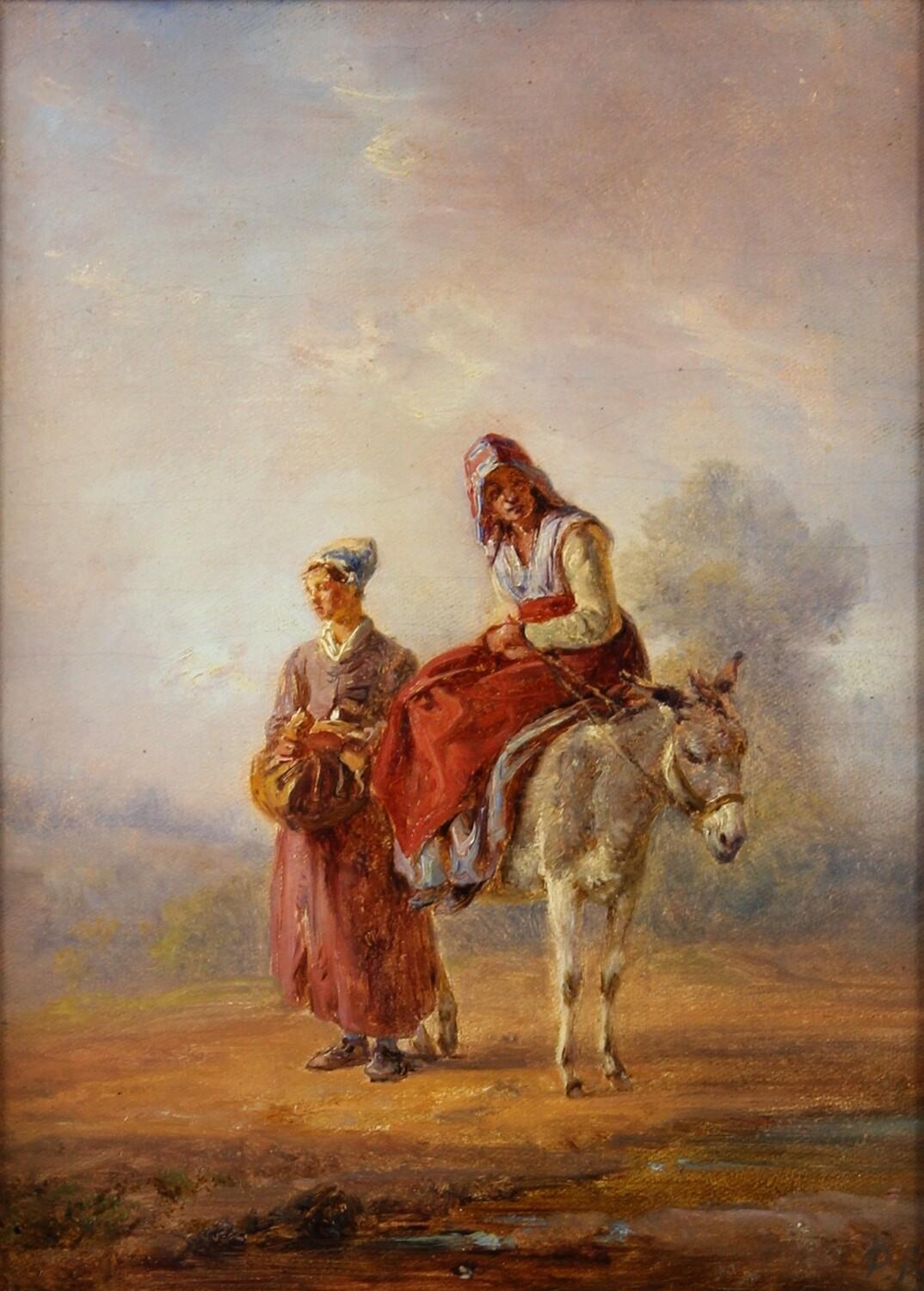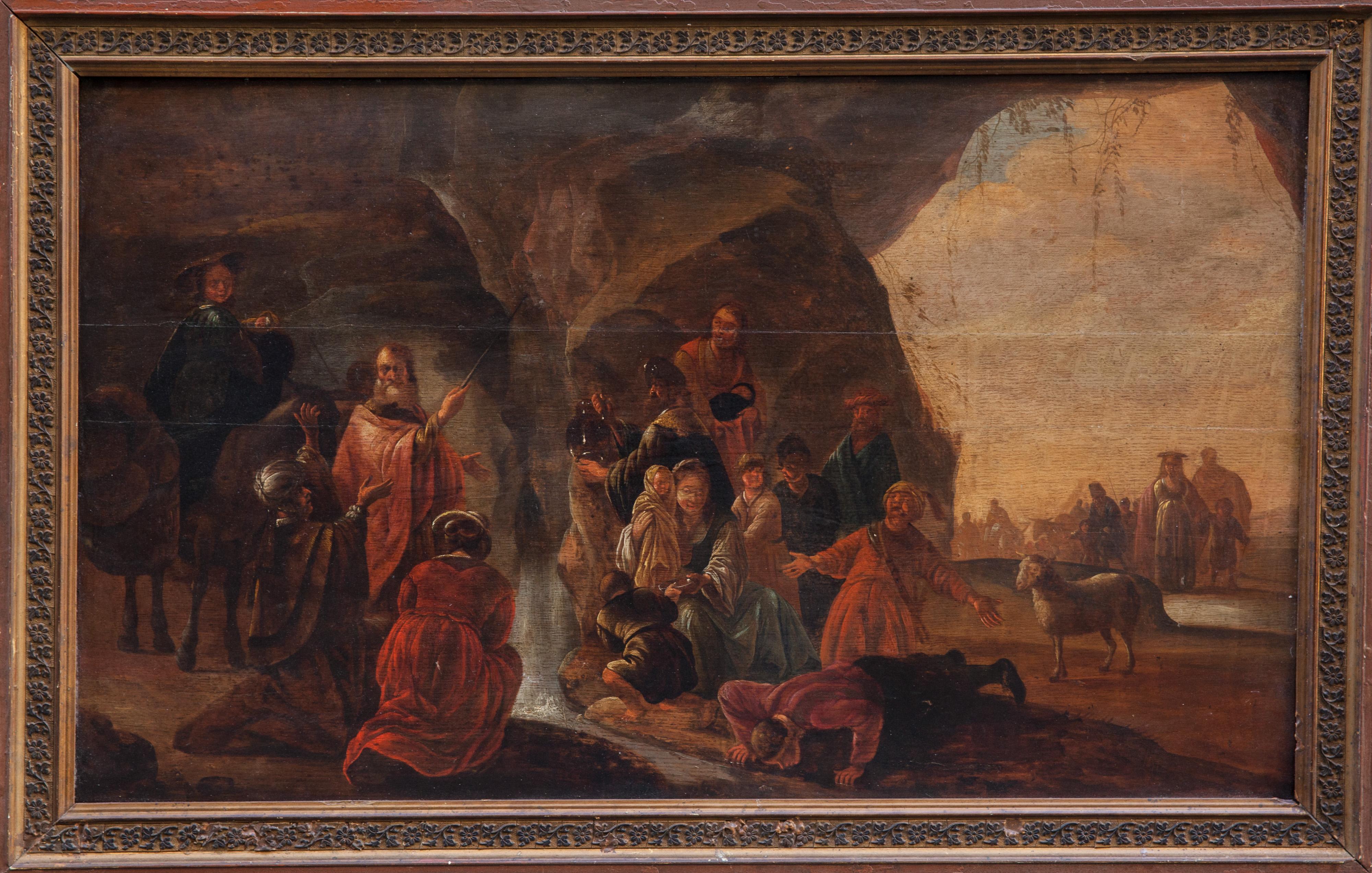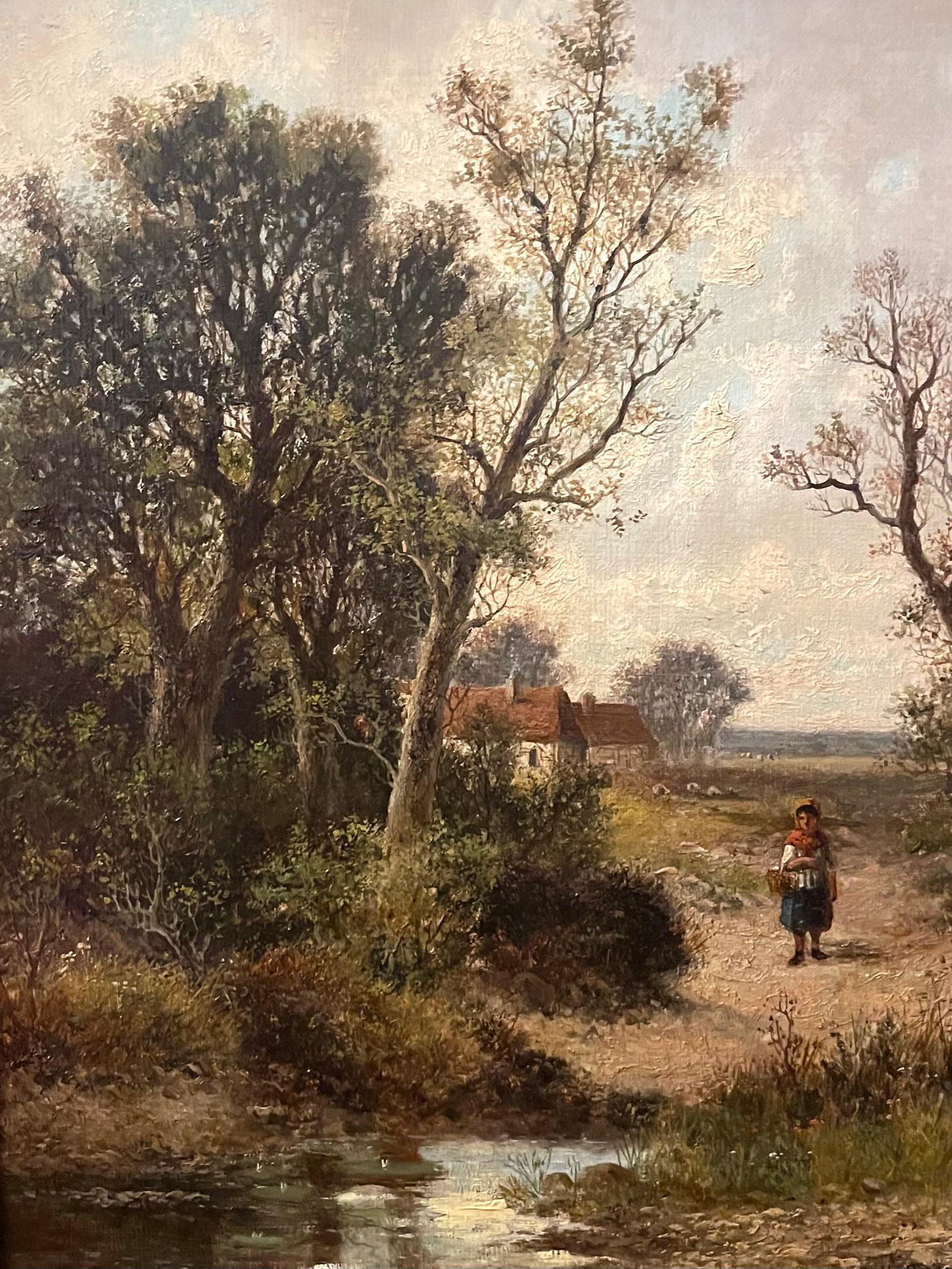Items Similar to Martyrdom of Saint Stephen- Painting attr. to Vincent Adriaenssen- 17th Century
Want more images or videos?
Request additional images or videos from the seller
1 of 8
Martyrdom of Saint Stephen- Painting attr. to Vincent Adriaenssen- 17th Century17th Century
17th Century
About the Item
Landscape with martyrdom of Saint Stephen is an old master artwork realized in 17th century.
Mixed colored oil painting on canvas.
Includes coeval gilded frame cm. 148x196.
The artwork is attributed to Vincent Adriaenssen called il Manciola (Antwerp, 1595 - Roma, 1675)
Among the painters who worked in the first half of the seventeenth century it is possible to indicate only the Neapolitan Scipione Compagno (1624-1680) as the author of scenes of martyrs set within a landscape or a view such as, for example, the Martyrdom of Saint Stefano recently hesitated at the Ansorena in Madrid on June 16, 2021. It should be noted, however, that the landscape represented in the painting examined here, characterized by luxuriant vegetation, meticulously represented "in the Flemish style", shows differences with the typical settings of the paintings di Compagno, characterized above all by urban views, visionary architectures or rather arid vegetation. Even the refined figures, so elongated and lanky, represented in our painting, in particular the group of knights in the foreground on the right, are not reflected in the production of the Neapolitan painter. These elements, to which we add the depiction of the Eternal Father amidst the clouds and the detail of the dog in profile in the foreground, instead recall a painter mainly known as a battle soldier, but who was also the author of many works depicting episodes from ancient Rome set within luxuriant landscapes, or rather Vincent Adriaenssen known as Manciola, a painter from Antwerp whose figure has been shed light thanks to recent studies. The group of horsemen represented to the right of the examined painting is, in fact, comparable with other groups on horseback present in numerous works by Manciola such as, for example, in the Triumph of Caesar (Rome, Babuino, 23-03-2010; formerly Florence, Collection Privata, 2006), while similar elongated and somewhat lanky figures, dressed in red, yellow, blue and white, can be found in the three paintings conserved at the Cassa di Risparmio di Pesaro, which in the past were erroneously attributed to the Umbrian painter Francesco Allegrini (1587-1663). Adriaensz, called Manciola because, lacking his right hand, he painted with his left, was a pupil of Pieter Paul Rubens (1577-1640) and his activity took place between Rome (from 1625 to 1645; from 1661 to 1675) and Paris (between 1640 and 1641; from 1645 to 1661) where, on the recommendation of Nicola Poussin, he worked for Chantelou and then for Cardinal Mazarin. Although there are few landscapes by Manciola that have come down to us with respect to the battles, in the ancient inventories there are, in reality, very numerous paintings representing landscapes that testify to a dispersed production of the Antwerp artist.
Reference bibliography:
- A. Marabottini, Two canvases by Vincent Adriaensz known as il Manciola and a late "errata corrige", in "Commentari d'arte", 12, 2006, pp. 41-50.
- C. de Aldecoa, Vincent Adriaenssen Leckerbetien dit il Manciola ou le Manchole Anvers, 1595 - Rome 1675: un peintre connu mais oublié, in “Bulletin de l'Association des Historiens de l'Art Italien”, 7. 2001, pp. 28-47.
- E.Fumagalli, A battalion found. Vincent Adriaenssen known as Manciola, in “Paragone”, 50, 1999, 28, pp.3-24.
- A.G. De Marchi, Manciola and more: notes on Battaglia's painting, in “Paragone”, 50, 1999, 28, pp.25-40.
- M.R.Nappi, The Neapolitan Philip by Roberto Longhi. Scipione Compagni or Cornelio Brusco, in Perspective, 47, 1986, pp. 24-37.
Expertise by Dr. P. Basso Bondini.
- Attributed to:Vincent Adriaenssen
- Creation Year:17th Century
- Dimensions:Height: 49.22 in (125 cm)Width: 68.9 in (175 cm)Depth: 0.04 in (1 mm)
- Medium:
- Movement & Style:
- Period:
- Framing:Framing Options Available
- Condition:Insurance may be requested by customers as additional service, contact us for more information.
- Gallery Location:Roma, IT
- Reference Number:
About the Seller
4.9
Platinum Seller
These expertly vetted sellers are 1stDibs' most experienced sellers and are rated highest by our customers.
1stDibs seller since 2017
6,713 sales on 1stDibs
Typical response time: 2 hours
- ShippingRetrieving quote...Ships From: Grasse, France
- Return PolicyA return for this item may be initiated within 14 days of delivery.
More From This SellerView All
- Two Arcadic Landscapes - J.F. Van Bloemen (follower of) - Oil on CanvasBy Jan Frans van Bloemen (Orizzonte)Located in Roma, ITTwo Arcadic Landscapes are a couple of original oil paintings by a follower of the Flemish artist, Jan Frans Van Bloemen (1662-1749). These old master's original paintings represen...Category
Early 18th Century Old Masters Landscape Paintings
MaterialsOil
- The Knight - painting - XVII centuryLocated in Roma, ITThe Knight is an original oil painting on canvas realized during the XVII century by an anonymous artist. Provenance: Pecci-Blunt collection. Good condition...Category
17th Century Old Masters Figurative Paintings
MaterialsCanvas, Oil
- The Lake - Oil Paint attr. to Tom Sander - 1989Located in Roma, ITThe Lake is an oil painting realized in 1989 and attributed to Tom Sander. Mixed colored oil painting on canvas. Includes frame: 66 x 5 x 90 cmCategory
1980s Contemporary Figurative Paintings
MaterialsOil, Plywood
- Harvesting Cotton - Original Oil Painting - 1981Located in Roma, ITHarvesting Cotton is an original contemporary artwork realized in 1981. Mixed colored oil on canvas Hand signed and dated by the artist on the lower margin Included a brown wooden...Category
1980s Contemporary Figurative Paintings
MaterialsOil
- Glücksburg Castle near Flensburg - Oil Painting- Early 20th CenturyLocated in Roma, ITGlücksburg Castle near Flensburg is an original modern artwork realized in the first half of 20th Century Oil on hardboard. Hand signed "H. Th. Nöbbe" on the lower margin. Include...Category
Early 20th Century Modern Figurative Paintings
MaterialsOil
- Streets of Tunis - Oil on Canvas by A. Sergheev - 1994Located in Roma, ITStreet of Tunisi is an original contemporary artwork realized by Alexander Sergheev in 1990s. Mixed colored oil on canvas. Initials of the artist on th e lower margin. Includes fr...Category
1990s Contemporary Figurative Paintings
MaterialsOil
You May Also Like
- Italian Landscape with Jack Players, a painting by Gaspard Dughet (1615 - 1675)By Gaspard DughetLocated in PARIS, FRHere Gaspard Dughet offers us an idyllic vision of the Roman countryside. The stages follow one another in a perfectly structured composition, revealing here a lake, there travellers walking along, gradually leading our eye to the blue horizon. But behind its classical composition, this landscape is particularly interesting because of three anthropomorphic details that the artist has hidden, opening the way to a radically different interpretation... 1. Gaspard Dughet, a landscape artist in the light of Poussin Gaspard Dughet was born on June 4th, 1615 in Rome where his father, of French origin, was a pastry cook. He was probably named Gaspard in honour of his godfather Baron Gaspard de Morant, who was, or may have been, his father's employer. His older sister Jeanne married the painter Nicolas Poussin (1594 - 1655) on September 1st, 1630. The young Gaspard was apprenticed with his brother-in-law at the beginning of 1631, which led his entourage to name him Gaspard Poussin. The first preserved works of the painter date from the years 1633-1634 and were painted in Poussin’s studio. Around 1635, Gaspard Dughet became emancipated and began to frequent the Bamboccianti circle. In 1636, he became friends with the painter Jean Miel (1599 - 1656), but also with Pier Francesco Mola (1612 - 1666) and Pietro da Cortona (1596 - 1669). This was also the time of his first trips throughout Italy. The painter, although of French origin, appears never to have visited France. In 1646 he settled permanently in Rome. A recognized painter with a solid book of orders, he remained faithful to landscape painting throughout his life, alternating between cabinet paintings and large decorative commissions, using both oil and fresco. Nailed to his bed by rheumatic fever at the age of 58, he died on May 25, 1675. 2. Discovering an idealized landscape Beyond a relatively dark foreground that takes us into the landscape, we discover a vast bluish horizon: a plateau surrounded by deep ravines advances to the right, overhanging an expanse of water that sparkles below. A road winds through a mountainous mass as if leading us to the fortress that crowns it; another town appears in the distance at the foot of three conical mountains. The composition is rigorous, mineral, and structured by geometric volumes. The various stages in the landscape lead one to the next attracting the eye towards the horizon located in the middle of the canvas. The general impression is that of a welcoming and serene nature. In many places the paint layer has shrunk, or become transparent, revealing the dark red preparation with which the canvas was covered and accentuating the contrasts. Human presence is limited to three jack players, leaning against a mound in the foreground. Their long garments, which may evoke Roman togas, contribute to the timelessness of the scene. Close examination of the canvas reveals two other travellers on the path winding between the rocks. Made tiny by the distance, their introduction in the middle register, typical of Dughet's art, lengthens the perspective. While it is difficult to date the work of a painter who devoted his entire life to the representation of landscapes, it is certain that this painting is a work from his later years. The trees that occupied the foreground of his youthful compositions have been relegated to the sides, a stretch of water separates us from the arid mountains counterbalanced by two trees represented on the opposite bank. The introduction of this stretch of water in the middle of the landscape betrays the influence of the Bolognese and in particular of the Dominiquin (1581 - 1641) A number of similarities with a drawing in the British Museum might suggest a date around 1656-1657, since, according to Marie-Nicole Boisclair , it has been compared with the Prado's Landscape with the Repentant Magdalene, painted at that period. 3. Three amazing anthropomorphic details While some late Renaissance landscapes offer a radical double reading, allowing one to see both a face or a human body behind the representation of a landscape, it seems interesting to us to hypothesize that Gaspard Dughet had fun here by slipping in a few details that, taken in isolation, evoke human or animal figures. We will give three examples, looking closely at a cloud, the trunk of a broken tree and the top of a cliff. The main cloud could thus evoke a Christ-like face or that of an antique god...Category
1650s Old Masters Landscape Paintings
MaterialsOil
- Stag Hunting in the Vicinity of Nuremberg by a German Artist Peter von BemmelLocated in PARIS, FRThis small landscape shows a hunting scene: two riders are chasing a stag with their dogs at the edge of a forest. Signed by Peter von Bemmel, it is typical of the production of this...Category
1720s Old Masters Landscape Paintings
MaterialsCopper
- 17th Century by Simone Cantarini Adoration of The Magi Painting Oil on CanvasLocated in Milano, LombardiaSimone Cantarini (Pesaro 1612 - Verona 1648) Adoration of the Magi Oil on paper applied to canvas, cm. 16,5 x 24 – with frame cm. 22 x 29 Antique sh...Category
Early 17th Century Old Masters Figurative Paintings
MaterialsCanvas, Cotton Canvas, Oil
- Two countrywomen with a donkey - Melancholy in an atmosphere of colour -Located in Berlin, DEPierre Louis De La Rive (1753 Geneva - 1817 Geneva). Two countrywomen with a donkey. Oil on canvas, mounted, 27 x 20 cm (visible size), 37 x 31 (frame), monogrammed "P.R." at lower right. About the artwork De La Rive has taken the typical scenes of Dutch landscape genre paintings...Category
1790s Old Masters Figurative Paintings
MaterialsCanvas, Oil
- Moses Strikes the Water from the Rock. XVII cent. Dutch school.Located in Firenze, ITMoses Strikes Water from the Rock Dutch school, XVII century. Workshop of Jacob de Wet (Haarlem, 1610-1675). Technique: Oil on oak wood panel, composed of 3 horizontal panels. In this evocative work, Moses stands in a cave, gathering the Israelites. There was no water to drink or for their cattle. The people were discontented in the desert. But Moses and Aaron listened to the voice of God. With Aaron’s staff, Moses struck the rock, and water gushed forth abundantly, quenching their thirst. Jacob de Wet’s workshop specializes in subjects from the Old and New Testaments. The recognizable rectangular format, simple compositions, and clear narratives define his style. The interplay of light and shadow, reminiscent of Rembrandt, adds timeless allure. The characters’ costumes, with their large hats and turbans...Category
17th Century Old Masters Figurative Paintings
MaterialsOil, Wood Panel
- Landscape Near Felday, SurreyBy Abraham Hulk the YoungerLocated in Hillsborough, NCDutch/English artist Abraham Hulk the Younger (1851-1922) is most known for landscapes of the British countryside. This work is one of a pair (the second work is also available by s...Category
Late 19th Century Old Masters Landscape Paintings
MaterialsOil, Canvas
Recently Viewed
View AllMore Ways To Browse
Set Of 3 Paintings
Painting Set Of 3
Vincent Artist
Paintings By Vincent
Roma Painting
17th Century Figures
17th Landscape Oil
17th Century Oil Landscapes
Old Master Style Landscapes
Florence View Painting
Flemish Landscape Painting
Gilded 17th
Painted View Of Florence
Paintings Set In The 17th Century
Old Cloud Paintings
Landscape Yellow Clouds
17th Century Figural Painting
Seventeenth Century Paintings





